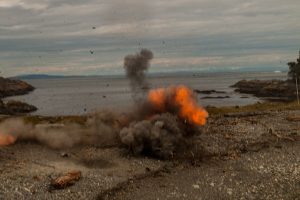Boom in training
By Lookout on Jun 25, 2012 with Comments 0
Fleet School boatswain students no longer have to pack a bag and travel across the country to receive Qualification Level 6 training to ready them for Range Safety Officer duties.
The three-month course, which includes two weeks of hands-on demolition training on Bentinck Island, is now available at CFB Esquimalt as a pilot trial. Only a handful of boatswains are chosen – between eight and twelve students for each serial.
Live training is always the most exciting, with students learning to set explosives and then detonating and watching it blow up. The upward spray of sand usually earns a gasp or two from them.
Bentinck Island, long ago a leper colony, is DND’s demolition range and test site range for explosives. Its location so close to Race Rocks Ecological Preserve means many procedures are in place to ensure continued protection of that area.
Fleet School pays particular attention to the time of the year, avoiding nesting birds, new seal pups and migration of marine mammals such as whales and sea lions.
Blasts are spaced out at a minimum of 10 minute intervals, and the size of the explosion is carefully monitored.
“We maintain a constant watch for all land and marine animals,” says PO1 Raymond Shaw, demolitions instructor of Fleet School’s Seamanship Division. “We continually work with outside agencies, cooperating with their studies as to how our training impacts the wildlife nearby at Race Rocks. We ensure our activities are conducted in a manner and in an area where there isn’t a chance of harming wildlife.”
To ensure the explosion is small, yet impressive, they use C4 plastic explosive.
“Its the same material that demolitions teams would use to clear beaches of a large objects, or clear navigational hazards at sea that could be dangerous to ships,” explains LS Daniel Rochat from Fleet School.
A few weeks ago, the second class to undergo QL6 training on the west coast experienced setting charges on the island.
Safety of all was at the heart of the lessons. LS Rochat says safety measures undertaken for demolitions training are very thorough in order to maximize the safety of the surrounding people and wildlife.
“Before conducting any live training, the Range Safety Officer (RSO) will designate sentries to various locations on Bentinck and a boat crew to watch for people in boats, wildlife and anything else that could be affected by the blasts. If anything or anyone comes within 1,000 metres of the island, training is stopped until the range is clear,” he says. “The RSO will also walk around the training area to make sure there is no wildlife around and to ensure it is also safe for the students.”
Instructors accompanied the students as they set the charges on the beach. Once all the charges were set, everyone returned to the blast hut. The range was declared clear by all sentries and the RSO, and then the students were given the order to conduct their drills in preparation for detonating the explosives, either by a timed fuse or electronically.
During their training, the Commandant of Canadian Forces Fleet School Esquimalt, Cdr Martin Drews stopped by to see the course in action.
Their next phase of training is on the rifle range (Heals Range) with the QL5 course. The QL5s will be learning how to act as safety numbers on a range and the QL6s will be learning to be an Range Safety Officer on the range.
Shawn O’Hara, Staff Writer
Filed Under: Top Stories
About the Author:






